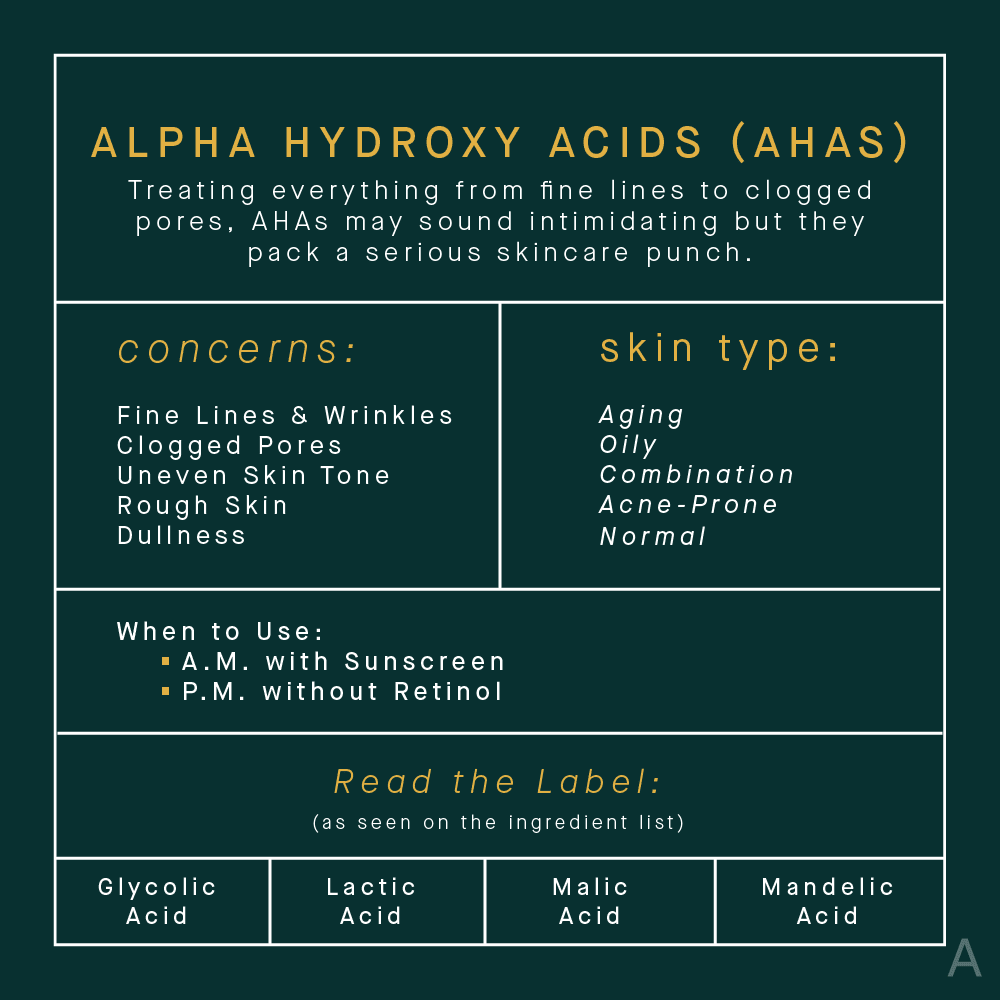 Superficial Chemical Peels
Superficial Chemical PeelsRead The Label: All Your Alpha Hydroxy Acid Questions Answered
Tackling skin concerns ranging from fine lines and wrinkles to clogged pores and dull skin, AHAs may sound intimidating but they pack a serious skincare punch. Here’s what you need to know.
Feel like you need a dictionary every time you look at the ingredient list of a beauty product? Still unsure of the difference between retinol and retinoids? What about the unique benefits of vitamins B, C, and E? Are alpha and beta hydroxy acids the same thing? The skincare aisle can be overwhelming, but you don’t need a PhD in cosmetic chemistry to navigate it. With expert help, The AEDITION is demystifying and simplifying the beauty industry — one label at a time.
Names can be intimidating – especially in beauty products. Be they confusing, complex, or misleading, intricate monikers can deter many from trying what is actually a dynamic ingredient. This couldn’t be more true than with alpha hydroxy acids (AHAs).
Although a mouthful, AHAs are nothing to fear. In fact, they should be celebrated for their affirmative action on many of the skin's biggest dilemmas. Quite potent in their composition, it’s no wonder AHAs are a favorite in both professional and over-the-counter chemical peels due to their ability to gently unclog pores and exfoliate the skin.
To help you understand what alpha hydroxy acids are, what they treat (we’re looking at you, wrinkles and skin discoloration), how to decipher the various types, and when to start using them, The AEDITION asked the experts.
What Are Alpha Hydroxy Acids?
AHAs are water-soluble acids (often derived from sugar) that have a similar pH to our skin, allowing them to absorb more easily. “AHAs dissolve connections between dead cells on the surface of the skin, so they can be exfoliated more easily,” explains New York City-based board certified cosmetic dermatologist Amy Spizuoco, DO. Their exfoliating prowess is also what allows them to stimulate collagen. “It is thought that – by creating low-grade skin irritation – they stimulate a wound healing response with new collagen production,” she adds.
The Benefits of Alpha Hydroxy Acids in Skincare

AHAs are great for those looking to “reduce wrinkles, brighten their skin, reduce acne, and lighten discoloration,” explains Joshua Zeichner, MD, a board certified dermatologist and director of cosmetic and clinical research in dermatology at The Mount Sinai Hospital in Manhattan. From acne to aging, the multifaceted benefits of the workhorse ingredient is why it is often utilized in light- and medium-grade chemical peels, as well as at-home masks, toners, and serums.
Breaking Down Alpha Hydroxy Acids
As you’ve noticed by now, AHAs (like vitamin A) come in different forms and are called by different names depending on the source. Here’s the breakdown:
- Glycolic Acid: Derived from sugarcane, glycolic acid is “the smallest of the AHAs, making it the most powerful because it can penetrate deepest into the skin,” Dr. Spizuoco says. It sloughs dead skin cells and can be found in professional glycolic acid peels, but also in products like the SkinCeuticals Retexturing Activator serum or Drunk Elephant’s T.L.C. Framboos™ Glycolic Resurfacing Night Serum.
- Lactic Acid: As per its name, it’s derived from lactose. “Its large size makes it a gentler alternative compared to other AHAs,” Dr. Spizuoco shares, adding that it can also act as a hydrator. According to Dr. Zeichner, lactic acids are best used as cleansers or as exfoliators. It can be found in the Sunday Riley Good Genes Treatment or Erno Laszlo Resurfacing Sleep Serum. The latter of which contains a 15 percent blend of lactic, glycolic, and citric acids.
- Malic Acid: “Derived from apples, it is commonly referred to as a ‘citric acid,’” Dr. Spizuoco explains. Gentler than glycolic and lactic, malic acid is often tolerated by sensitive skin types. “It has a mild effect on the skin to even out skin tone and boost collagen production,” she says. Not to mention, it doubles as a humectant – like hyaluronic acid – meaning it helps the skin hold onto moisture.
- Mandelic Acid: Sourced from bitter almonds, it has a larger molecular size than glycolic and lactic acid and is more oil-soluble than its counterparts. As a result, it is gentler like malic acid and a milder option for those with sensitivity or dryness. It is often safe for those with “rosacea-prone skin because it helps reduce inflammation,” Dr. Zeichner notes.
Additionally, there are also lesser-known fruit-derived AHAs like tartaric and citric acids that are primarily used as pH stabilizers within skincare.
The Difference Between Alpha Hydroxy Acids and Beta Hydroxy Acids
No conversation about AHAs is complete without mentioning beta hydroxy acids (BHAs). But don’t let the terminology confuse you — there’s nothing ‘beta’ about BHAs. What separates the two sets of acids is not their efficaciousness but rather their compositions. “Alpha and beta hydroxy acids are structurally different,” Dr. Spizuoco says. “The prototypical beta hydroxy acid is salicylic acid. BHAs are very soluble in oil, which is why they are more commonly used in oily skin and acne.” While there are an array of AHAs to choose from, salicylic acid is the lone BHA in skincare. As Dr. Zeichner explains, “BHAs tend to cause less irritation than AHAs.”
When To Use Alpha Hydroxy Acids
Because AHAs have a variety of skincare benefits, they can address numerous skin issues. “AHAs can be used to treat acne, rosacea, melasma, hyperpigmentation, and wrinkles,” Dr. Zeichner says. “So, as soon as these conditions occur, AHAs can be used.” Due to the different types of AHAs, those with more sensitive skin can incorporate them into their skincare routines, so long as they first consult with a dermatologist or aesthetician. Side effects can include redness, drying, irritation, and peeling when applied at a high concentration.
Unlike physical exfoliants (think: face and body scrubs) that manually remove dead skin cells, AHAs are a chemical exfoliant. When applied, they often impart a tingling sensation that lets you know they are getting to work. When first introducing an AHA product into your regimen, consider the concentration. It is recommended to start low (below 10 percent) and build up to a higher dose as your skin adjusts.
Depending on your routine and your skin's needs, there are several ways to utilize AHAs. “AHAs are best used in the morning, especially if you also using retinol,” Dr. Zeichner warns. “They shouldn't be used together in order to minimize irritation.” You might consider following it up with hyaluronic acid to lock in the moisture. For those who aren’t using retinol and wish to wake up to the radiance-boosting benefits, doing an AHA treatment or applying a serum before bed can supercharge your beauty sleep.
No matter when you use them, one thing remains a must to ensure your exfoliated skin remains protected from the sun: sunscreen. “Make sure to wear sunscreen every morning if you are using AHAs because they thin out the top layer of the skin and can increase your risk of sunburn,” Dr. Spizuoco says, adding that you should be wearing sunblock all day, every day regardless.
The Takeaway
Brightening, tightening, and clarifying, alpha hydroxy acids are not as scary as they sound. Found in both over-the-counter and professional-grade products and treatments, the chemical exfoliants remove dull, dead skin cells to reveal more radiant skin. Knowing what to use and when to start can be confusing, so be sure to consult with a board certified dermatologist to better understand how adding AHAs to your skincare routine can give your skin a youthful glow, day or night.
All products featured are independently selected by our editors, however, AEDIT may receive a commission on items purchased through our links.
More Related Articles
Related Procedures

AI Plastic Surgeon™
powered by'Try on' aesthetic procedures and instantly visualize possible results with The AI Plastic Surgeon, our patented 3D aesthetic simulator.
